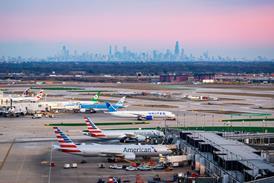By Michael Wilson in London: Flight International 24 June 1969
Man stood for the first time on another planet last Monday morning, July 21. An estimated 600 million people, the largest-ever live audience to watch any human endeavour, saw on television the bulky figure of the Apollo 11 commander, Neil Armstrong, climb backwards down the aluminium ladder, place his right foot in the spacecraft landing pad, and gingerly step down to the surface of the Moon. Science fiction became fact; the dream of centuries was realised.
But the first walk on the Moon was almost anti-climactic after the tense period beginning with the separation of Columbia and Eagle, and leading up to the landing. At 1847 BST the two craft undocked and separated slightly, allowing Collins in the command and service module to inspect the LM visually for damage.
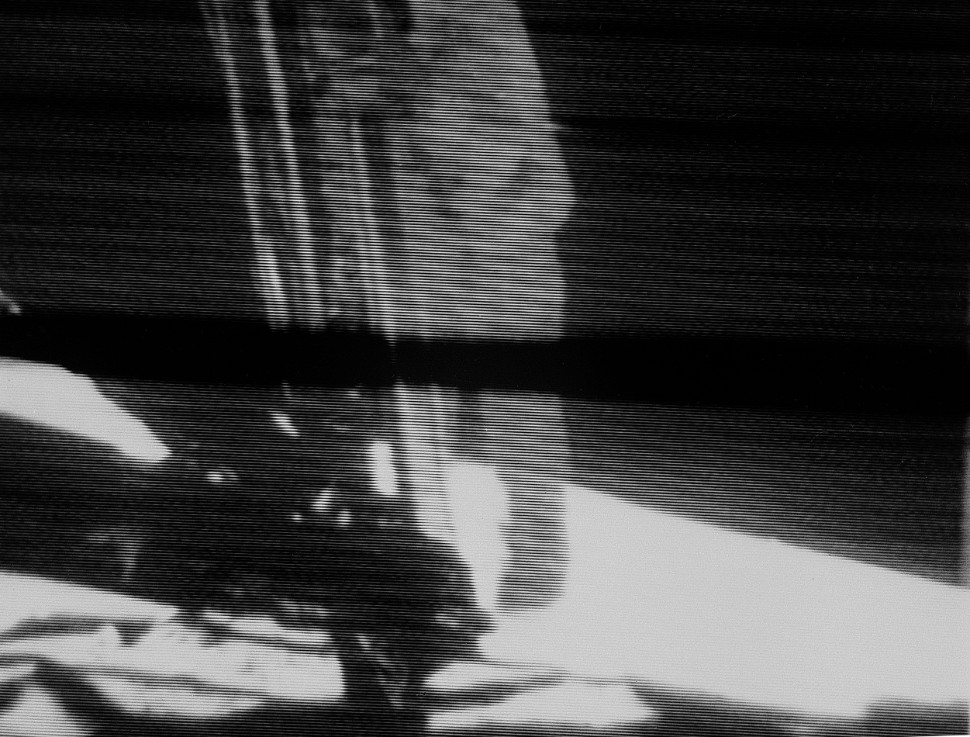
Classic first-step image: from 250,000 miles, TV pictures were crude in 1969
NASA
Adding further drama to this great adventure was the news from Jodrell Bank, at 1925 BST, that the enigmatic Luna 15 had changed its orbit, and was now within ten miles of the surface. Were the Russians planning a simultaneous landing? No one knew. After a final “clear” from Houston, the LM descent engine was fired (behind the Moon) on the 13th orbit at 2011 BST on Sunday in the de-orbit burn, to reduce the velocity of the spacecraft so as to put it on a collision-course with the Moon. The command module appeared from behind the Moon, at 2047 BST. Collins’ comment was: “Everything’s going just swimmingly.” Two minutes later the LM appeared, the imperturbable Armstrong reading out a string of computer data.
During this stage the LM was in a ballistic trajectory, following very closely the computed flight-path, which was virtually identical to that of Apollo 10. As a result of the data returned by this flight, a new mathematical model of the Moon and its perturbing mascons had been prepared by Boeing for Apollo 11.
During the descent some trouble was experienced with voice transmissions from Eagle, owing to an oscillatory condition with the steerable communication antenna, and this emphasised the outstanding quality of voice reproduction otherwise characteristic of this flight.
STRIKING DISTANCE
At 2101 BST: “Eagle from Columbia. You’re go for PDI” (the CM was relaying the power-descent initiation signal from Houston to the LM); 5min later Eagle had arrived at the “high gate,” 50,000ft above the Moon and 260 n.m. from the predicted touchdown point. With the continued slight pitchdown of the LM, this was the first occasion on which Armstrong and Aldrin were able to see the surface since beginning the de-orbit manoeuvre. The descent engine was fired again to provide the braking thrust.
The most critical part of the flight was now approaching. At about 39,500ft the all-important landing radar was switched in to update the altitude data in the LM guidance computer. During this time each astronaut was paying particular attention to three instruments: the spacecraft flight director, the fuel gauges, and the indicator displaying range and altitude and their corresponding rates. The clipped comments continued steadily. “You’re go to continue powered descent” (Houston, 2110 BST). “Good radar returns, altitude 33,000ft. This is better than the simulator” (Eagle, 2112 BST). “Things look real good, you’re go for landing.” “Fourteen hundred feet, still looking very good” (Houston). Armstrong had now taken over manual control in order to traverse a football pitch-sized shallow crater filled with a large number of boulders and rocks.
The stream of comments from Eagle became even more clearly audible. “Seven hundred feet, 21 down, 33°… 540ft… 15 down, 30°… Looks good. Down a half… six forward. Sixty-second light on… down two and- a-half… four forward, four forward… We’re picking up some dust.”
At 2118 BST came the matter-of-fact words: “Contact lights. OK, engine stop. Tranquillity Base here. The Eagle has landed.” Nearly as historic as Caesar’s “Veni, vidi, vici” and certainly more widely reported. It was followed by the Houston reply, “We copy you down, Eagle. We’ve got a bunch of guys about to turn blue.” Indeed, Houston could now release its collective bated breath.
And so did man land on the Moon, at 21hr 17min 42sec BST on Sunday, July 20, 1969.
Eagle had landed at Site 2 in the Sea of Tranquillity, four miles downrange of the predicted touchdown point (part of this deviation due to mascon-induced errors) and 37sec later than predicted. The ground here was flat, the spacecraft tilt being well within allowable limits at 4.5°. A thin cloud of dust rising to about 70ft, raised by the descent engine, did not obscure visibility.
But if the LM had stopped, work hadn’t. A 3min window existed during which take-off and rendezvous with Columbia was possible. But Eagle was still go, and Houston gave the clear to stay on the Moon for the next 2hr (by which time Columbia would again be in the correct position for a rendezvous). The first job was to go through the simulated countdown.
EVA RESCHEDULED
For the past day or so there had been a suggestion, emanating from Armstrong, that the EVA (extra-vehicular activity) be brought forward, so dispensing with the four hours’ sleep which had been scheduled. This was finally agreed by NASA, and in particular by Dr Berry. The crew had slept very well, and were superbly fit. Armstrong’s contention was that they could hardly be expected to sleep with a whole new world outside waiting to be explored. Also, pulling back the EVA some 4hr would bring it back to late evening – peak TV viewing time – in America.
The decision to advance EVA was made around midnight. At first scheduled for 0232 BST on Monday morning, it was later put back to 0300 BST owing to the crew’s difficulties in donning their suits. The go-ahead to depressurise the LM in preparation for the walk was given by Mission Control at about 0258 BST.
The LM was depressurised, a final check of the LM and the spacesuits was made, gloves were put on. “Buzz” Aldrin was reading back his check list. The atmosphere at Houston was suddenly informal – it was “Neil – Houston, would you confirm…” Armstrong went on to his PLSS (portable life-support system) at 0329 BST. The minutes ticked interminably by without any sign of movement, and then, at 0353 BST, Armstrong reported that he was on the porch of the LM. Two minutes later the large TV screen at Houston flashed out. There was the vague shadowy figure of the Apollo 11 commander, seen initially upside down. The picture was quickly righted. Armstrong came down the ladder very slowly, pausing at the lowest rung to test his ability to climb back up again. Then: “I’m at the foot of the ladder now. The LM footprints are only indented about 1in-2in in very fine ground.” The next instant, at 0356 BST, and 109hr 42min from launch, he stepped on to the Moon. His comment, “That’s one small step for man, one giant leap for mankind,” must surely enter the history books.
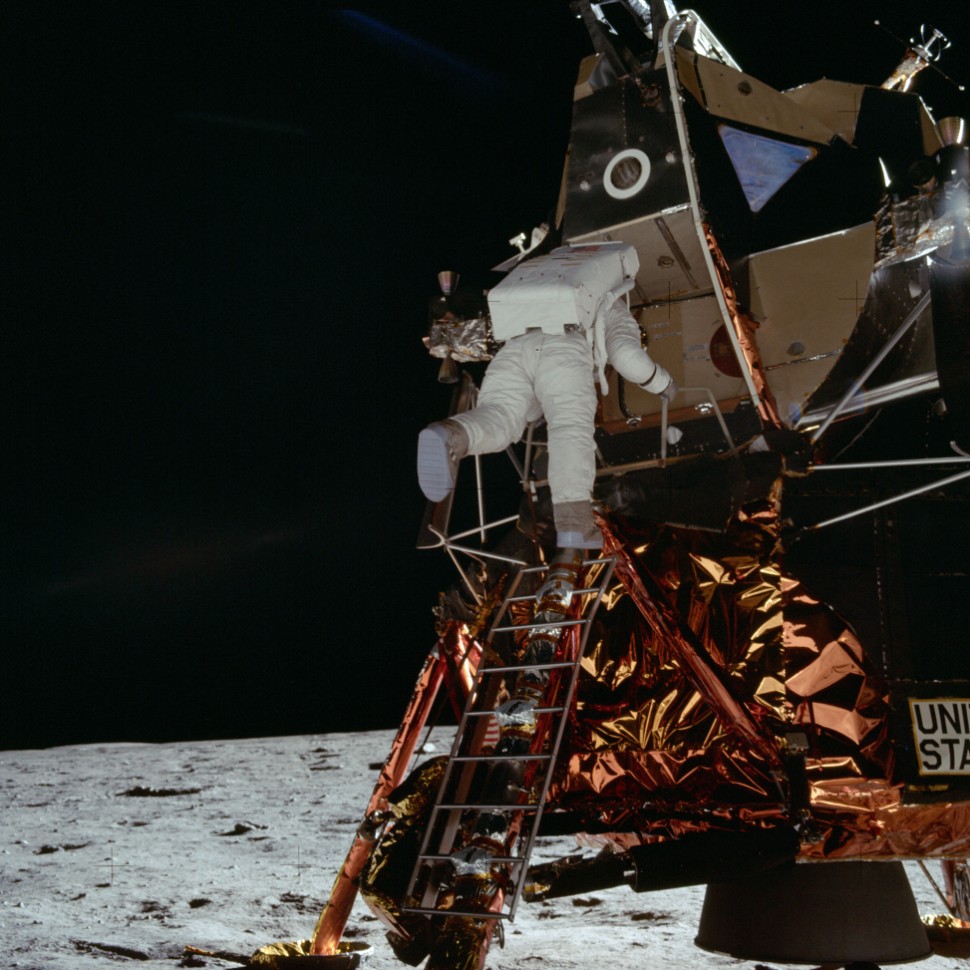

After Apollo 11 returned home and the film was developed, priceless images were abundant; Armstrong handled the camera, so Aldrin appears most frequently
NASA
His next observations concerned the nature of the lunar surface. “The surface is fine and powdery. It adheres like powdered charcoal to the soles of my boots… there seems to be no difficulty in moving about, as we suspected… it is perhaps even easier moving around in one-sixth g than it was in the simulator… the descent engine didn’t leave a crater of any size … I can see some evidence of rays [on the surface] emanating from the descent engine.” TV picture-taking was initiated by Armstrong, as he climbed down the ladder, pulling a lanyard which opened the MESA (modular-equipment storage assembly) bay in the descent stage and revealed the Westinghouse camera rigidly mounted to record the moment.
Aldrin passed a survey camera down, by way of the lunar-conveyor equipment, to Armstrong, who began landscape photography; Mission Control, ever conscious of the pressing timetable, reminded him of the need for a contingency soil sample (necessary in case an emergency take-off prevented bulk loads from being secured). Armstrong then assisted Aldrin out of the LM, the latter stepping on to the surface at 0415 BST to the accompaniment of comments such as: “Beautiful, beautiful… magnificent desolation.” Three minutes later Armstrong was jumping up and down – sure enough, in slow motion.
He commented that balance and recovery from upset were normal (despite the destabilising effect of the heavy back-pack). The commemorative plaque, mounted on the ladder, was unveiled at 0425 BST, after which the TV camera was carried about 80ft from the LM and set up on a tripod so that the spacecraft and most of the EVA activities could be viewed continuously.
MAKING A MARK
Aldrin erected the American flag with its automatic unfurling device; cynics might have wondered if this traditional act of nationalism was really necessary. Congress had already decided not to send the United Nations flag. Then Collins, aboard Columbia, came up over the horizon to remind everybody that this was a three-man show. After some experimental kangaroo hopping, Armstrong declared that this mode of progression was inefficient.
Ceremony then took its place. At 0449 BST President Nixon, speaking from Washington, exchanged greetings with the two men (who stood stiffly to attention beside Old Glory), addressing them as Neil and Buzz, but apparently forgetting driver Mike upstairs.
A certain amount of apprehension was beginning to show in the Houston controller’s voice. Partly as a result of the long period between donning the portable life-support system and starting EVA, the operation was already running some 30min late. The back-packs, which had been operating since 0329 BST, had consumables for 4hr, and it was beginning to be evident that either an extension of EVA or a change of programme would be needed. By 0527 BST one of the main functions of EVA – the deployment of the two main items in the EASEP (early Apollo scientific experiments package) was under way. These experiments, comprising a laser reflector and a passive seismometer, were carried by Aldrin from their storage bay in the LM out on to the surface to be set up there. Significantly, there was still no mention of fatigue or difficulty in moving around.
By 0537 BST the laser reflector was deployed, but considerable levelling difficulties with the seismometer ate into the precious EVA time and Houston was becoming decidedly edgy. Finally Mission Control said it would like to extend the excursion by 15min. Did the crew mind? Evidently the crew didn’t.
Although the contingency sample had been collected and some 20lb of bulk sample secured (it was not clear whether this was 20lb by Earth or Moon weight), the documented samples were still to be obtained. Signals from the laser had already been recorded in California. The laser reflector was also checked out from Earth.
SAMPLES COLLECTED
At 0547 BST Aldrin collected a coretube sample at a depth of about 6in. “It almost looks wet,” was his comment. Time was rapidly running out. “Neil, after you’ve got the core tubes and solar wind [experiment], anything you can throw in the box will be acceptable” came the plaintive cry from Houston. The dignified academic selection of rocks degenerated into a scramble. At 0558 BST Aldrin was mounting the ladder, after 2hr 30min operation of his life-support system. At 0600 BST camera magazines and sample boxes were being loaded aboard Eagle by means of the pulley system. By 0612 Armstrong was back in Eagle, and the hatch was closed.
The first operation was to pressurise the spacecraft, after which the astronauts went through the tiring process of removing their thermal-meteoroid garments. A checkout of the spacecraft was followed by a meal, after which Armstrong and Aldrin settled down for a rest. Accommodation in the LM is severely limited; Armstrong slung a hammock over the base of the ascent-stage engine, while Aldrin curled up on the floor.
After a 7hr doze the two men began preparations for countdown. Luna 15 continued to provide interest; Jodrell Bank reported that the signals from the Russian spacecraft had ceased at 1655 BST. It was surmised that the craft had crashed or landed on the Moon at 300 m.p.h., in the region of the Sea of Crises some 400 miles from the Apollo 11 landing site.
The countdown continued. At 1845 BST Houston came on with a reassuring: “Everything looks good.” The two astronauts were now too busy to admire the view as the last minutes of the first manned landing mission to the Moon ticked by. The 3,500lb ascent engine ignited. Eagle lifted from its launch pad – the silent descent stage. “Beautiful,” was Houston’s comment. Two minutes later the spacecraft was at 9,000ft and heart-rates (which had peaked at 94 for Armstrong and 120 for Aldrin) began to subside. The flight-path was good. “Eagle – Houston: You’re right down the track,” from Mission Control.
At 1901 BST the engine was shut down, with Eagle at a height of 60,666ft (in a 9.1 n.m. by 47.2 n.m. orbit), travelling at 5,537ft/sec and some 166 n.m. from Site 2. Some 5,000lb of fuel had been burned to put Eagle back in Moon orbit.
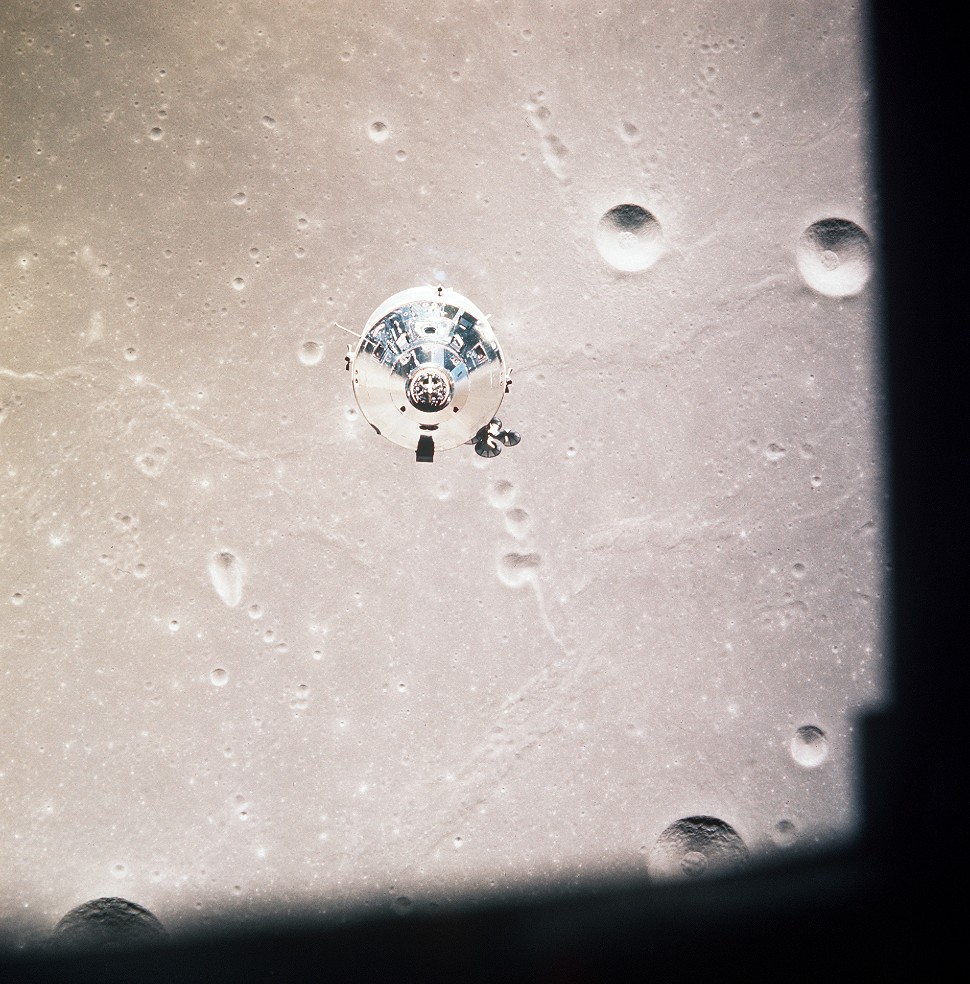
Command module as seen from lander…
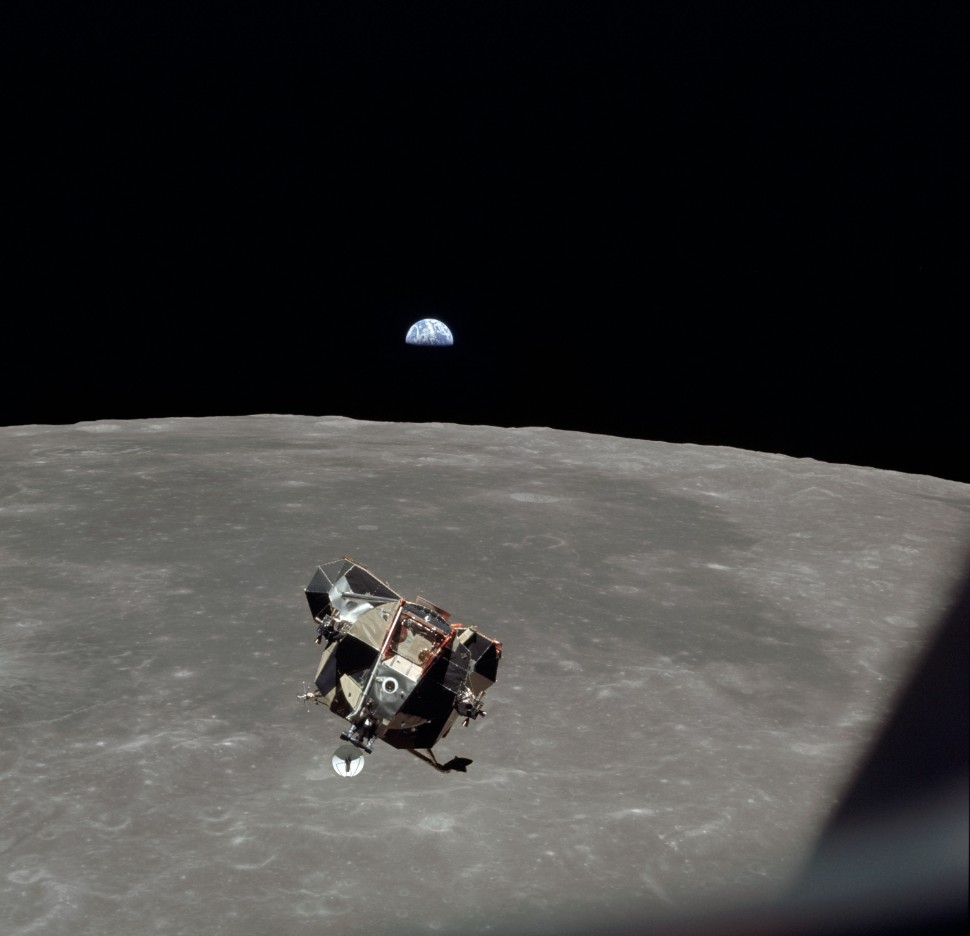
…and lander viewed from Command Module on its way back from the surface
NASA
As we went to press, just after injection of the LM into orbit, both this spacecraft and the command module (which was coming round the Moon on its 25th revolution) were reported to be in good condition, and the docking was successfully accomplished. The concluding stages of the flight will be reported in Flight next week.
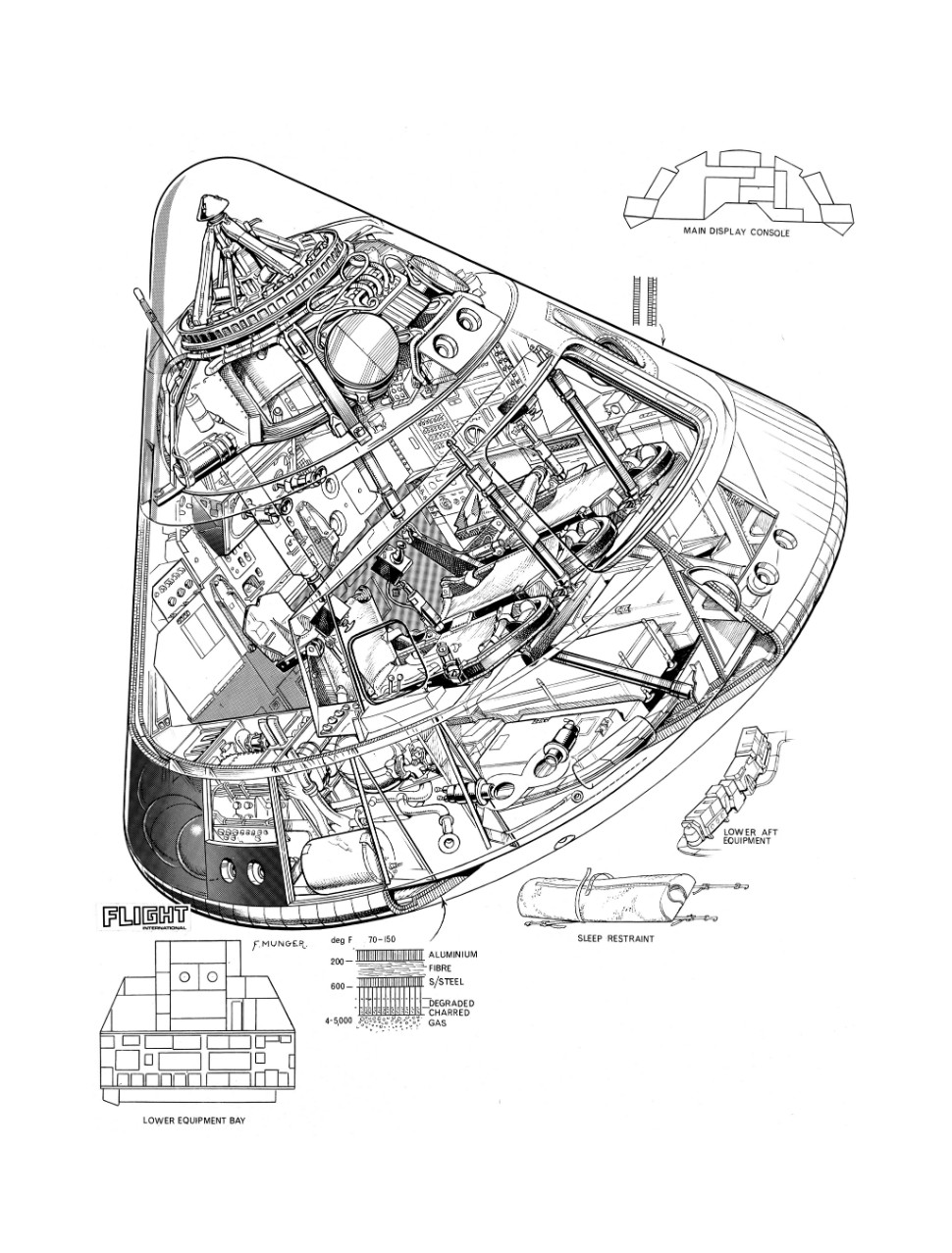
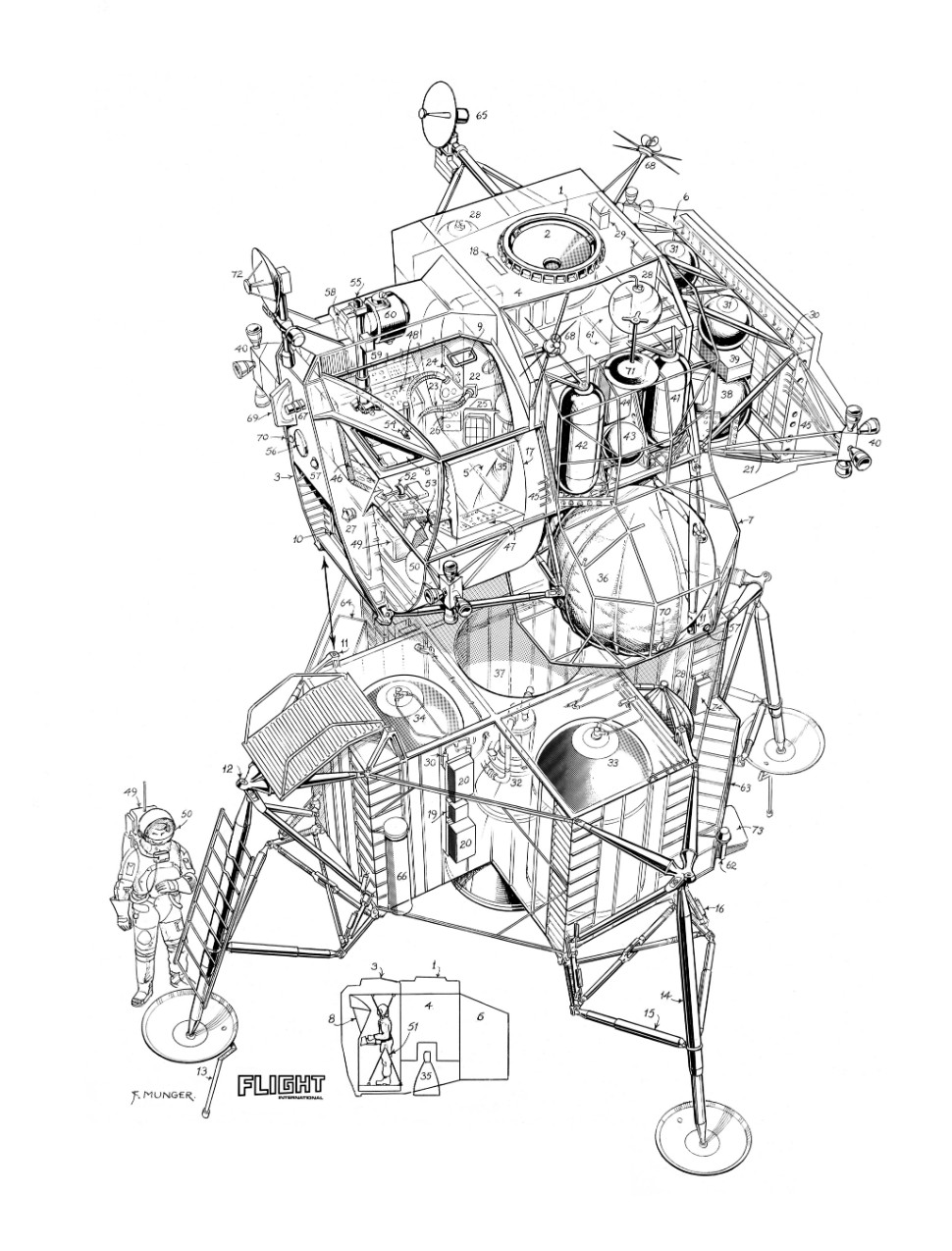
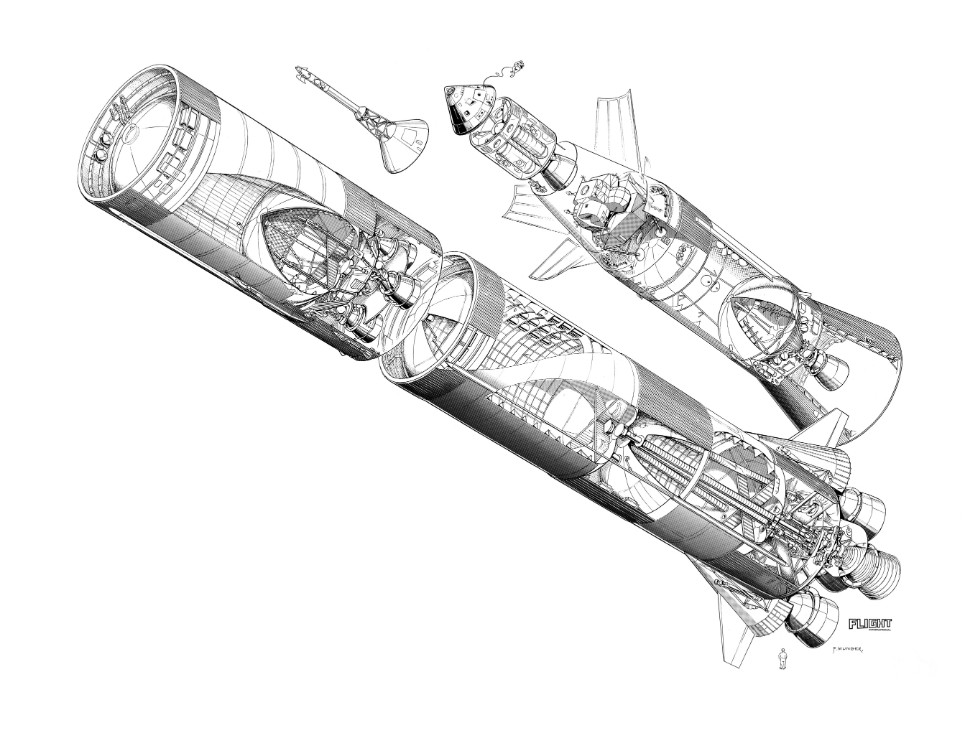
Flight’s Frank Munger reproduced the Apollo 11 hardware with characteristic precision
Source: Flight International


